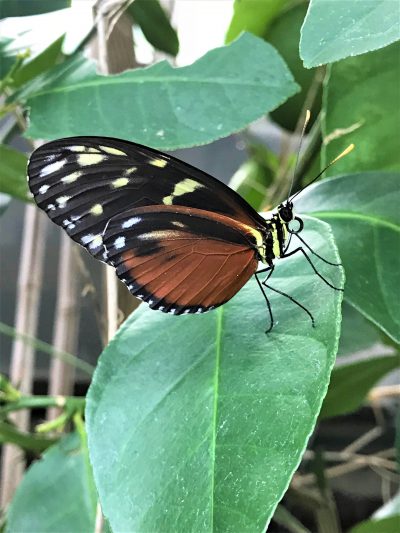Do butterflies really taste through their feet?
Many insects, including butterflies, have contact chemoreceptors on their legs. They can also taste with sensory organs on their mouth parts. Insects have sensory organs on different parts of their bodies. Some butterflies can ‘see’ with their back ends, and ‘hear’ with their wings. – Dr. Jayne Yack
Taste involves detecting chemicals upon contact or “contact chemoreception”. Butterflies do indeed have contact chemoreceptors on their feet, so yes, they “taste” plant chemicals through their feet, just as we use the receptors on our tongue to taste our food. However, a female butterfly doesn’t taste the plant leaves because she is interested in eating them herself. Her main concern is finding an appropriate plant for her offspring to feed on. She needs to detect the right combination of chemicals on a leaf to determine whether that plant is safe (not toxic) for her caterpillars before she lays an egg. – Dr. Naomi Cappuccino
Butterflies have chemoreceptors on their feet that act like human taste buds. A female butterfly will drum the leaves with her feet to release the plant juices. She is searching for the right plant chemicals and if it is a match will lay her eggs. These chemoreceptors sense dissolved sugars in fermenting fruit. A favorite snack for tropical butterflies. – Greenhouse Manager, Ed Bruggink
Yes — it’s true. Many insects ‘taste’ with strange parts of their bodies in comparison to how people (i.e. humans) taste (and smell) things — we use our mouth and nose. Taste (and smell) is essentially a process of detecting molecules in the environment and sending messages to the ‘brain’ for processing. Butterflies have receptors on their feet that detect molecules in their environment — basically, detecting the molecules of/in what they are standing on. Ditto for their antenna detecting molecules wafting along in the air (like pheromones). Is taste to a butterfly the same as taste to a human? Well… what is perceived depends on how the butterfly interprets the messages arriving at it’s brain. Clearly a butterfly brain is different than a human brain so it’s very unlikely that both humans and butterflies ‘perceive’ the deliciousness of an orange slice in the same way. – Dr. Jeff Dawson
Visit our Instagram page, @cuButterflies, for more facts!
